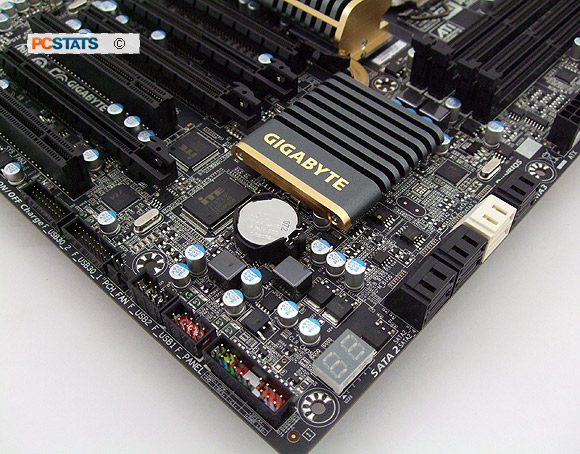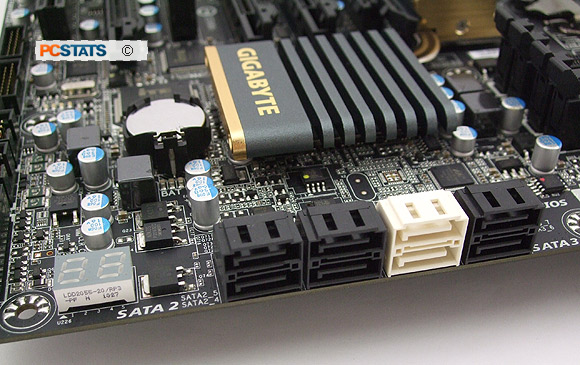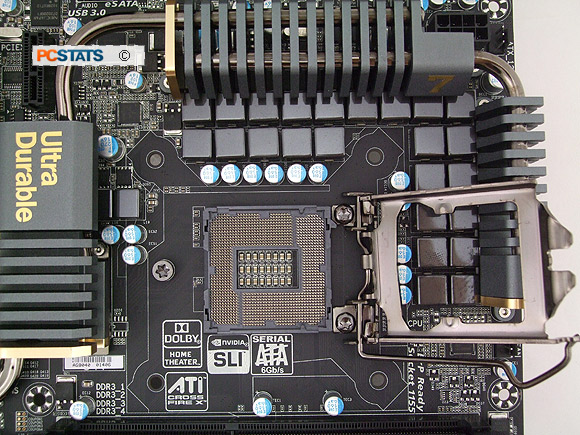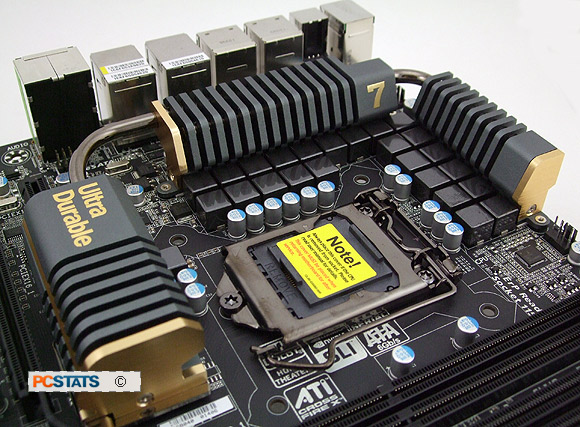The block diagram for the Gigabyte GA-P67A-UD7 motherboard outlines
all peripherals included with it and how they connect with the Intel P67 chipset.
PCSTATS will be breaking things down bit by bit and explaining this
in greater detail, but as you get more experienced with computer systems it's a
good skill to be able to read and understand these representative illustrations.
Gigabyte's GA-P67A-UD7 motherboard supports 3-way SLI and
3-way Crossfire across its dual PCI Express 2.0 x16 videocard slots and two
PCI Express 2.0 x8 slots. This board is built for multi-videocard gaming. Note the
nVidia NF-200 chipset just north of the top PCI Express slot and Intel P67 chipset
to the right (both under heatsinks).
Run two videocards in x16/x16 mode, three videocards at
x8/x8/x8 mode.
|

Port 80 card for troubleshooting overclocking
issues....
|
In this corner of the
Gigabyte GA-P67A-UD7 motherboard we find a Port 80 card to help debugging issues when overclocking, a
pair of USB 3.0 headers (four internal USB 3.0 ports!) and plenty of SATA
ports.
|

Two native SATA
6GB/s ports, four SATA 3GB/s ports
|
The Intel P67 chipset natively supports two SATA 6GB/s
and four SATA 3GB/s connections. Gigabyte have added two Marvell SE9128
controllers to this board to increase the number of SATA 6GB/s port by an
additional four. These are connected via a PCI Express x1 link to the P67
chipset.
The four DDR3 memory slots will accommodate up to 16GB
(64-bit OS) of dual channel DDR3-2133/1866/1600/1333/1066 memory. Gigabyte
provide a nice big physical power button for out-of-box tweaking. Just to the left are system reset and CMOS
reset buttons.
|

Socket 1155 for Intel Sandy Bridge
processors.
|
While Intel has created several different heatsink sizes in recent years
(LGA775, 1156 and 1366), the socket 1155 heatsink is thankfully interchangeable with existing
socket 1156 heatsinks. The 32nm Sandy Bridge processor
is expected to have a modest TDP of between 65W and 95W.
|

Clearance is good around the CPU
socket.
|
The 8-layer PCB has extra thick copper inner layers.
Big and chunky passive aluminum heatsinks and heatpipes
help cool the special 3-in-1 MOSFETs that form part of Gigabyte's 24-phase
CPU power supply. Since CPU VRM is connected by heatpipe and
indeed soldered to Gigabyte's custom 2 ounce copper motherboards, this should help
reduce component temperatures. Fine tuning features of the GA-P67A-UD7 motherboard
are next...
